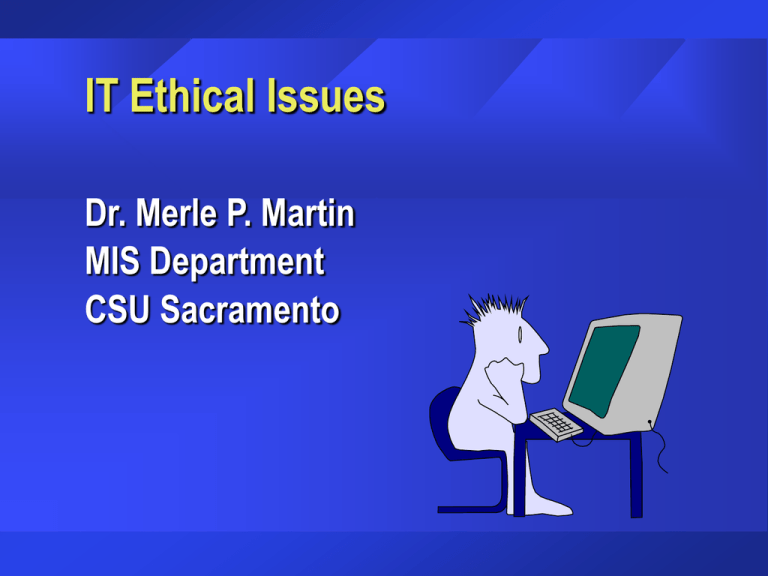IT Ethics
advertisement

IT Ethical Issues Dr. Merle P. Martin MIS Department CSU Sacramento Agenda Fair Information Practices (FIP) Ethics Issues IT Mistakes IT Crime Invasion of Privacy Corporate Code of IT Ethics Fair Information Practices (FIP) US Dept Health, Education and Welfare 1973 Framework for ensuing laws There will be no personal record system whose existence is secret. Fair Practices Individuals have rights of access, inspection, review, and amendment to systems that contain information about them. There must be no use of personal information for purposes other than those for which it was gathered, without prior consent. Fair Practices Managers of systems are responsible and can be held accountable and liable for the damage done by systems, for their reliability and security Governments have the right to intervene in the information relationships among private parties. Ethical Issues IT increases, particularly in processing and storage, have led to increases in: numbers of mistakes computer crime invasion of privacy unethical behavior IT Mistakes Data entry errors Programming errors Mishandling of IT output Inadequate planning for / control of equipment malfunctions Inadequate planning for / control of electrical, humidity, and other environmental problems. Preventing IT Errors Training Documentation Controls / standards Involvement of: managers end-users IT specialists Computer Crime Add / delete / modify inputs Modify / develop programs that commit a crime Alter / modify data files Operate IT in a way to commit a crime Divert / misuse valid output Role of auditor Security / Privacy Security is protection of data which, if wrongly disseminated, may damage organizational goals. Privacy is protection of data which, if wrongly disseminated, may damage individuals. Natural motivation to protect security Must have laws to protect privacy. Privacy Acts Privacy Act (1974) protection from federal govt. Fair Credit Reporting Act (1970) Tax Reform Act (1976) Electronic Funds Transfer Act (1979) Privacy Acts Right to Financial Privacy Act (1978) Freedom of Information Act (1970) Education Privacy Act Computer Matching and Privacy Act (1988) Ethics A means for judging right from wrong behavior through a set of cultural / organizational values, and a standard for acceptable conduct. IT Ethics Problems Unauthorized software copying (bootlegging) Knowing of wrongful acts, but failing to inform supervisor Knowing a software problem and using it to your advantage Unauthorized viewing of confidential information, including E-mail IT Ethics Problems Passing confidential info to unauthorized persons Knowing of error in data through unauthorized access, yet not informing anyone Following orders of supervisor although by doing so you knowingly commit an illegal act Mason’s PAPA Model Privacy Accuracy Property Access Privacy What info about individuals should be revealed? What safeguards are in place to protect a person’s privacy? What information can a person keep private and confidential, and not be forced to reveal to others? Accuracy Who is responsible for data accuracy? Who is accountable / liable for inaccurate data? What safeguards have been established to ensure accuracy? What can individuals do to ensure that data stored on them is accurate? Property Who owns the information? Who has the right to buy or acquire the information? How should access to intellectual property be regulated? Who places a value on intellectual property? Intellectual Property Rights Trade secrets: software, if not in public domain Copyright 1980 Computer Software Copyright Act Patent 1981 Supreme Court decision allowed software to be patented Access What information does a person have a right to access? What safeguards exist for information access? How do we guarantee equal access across social and economic groups? Shneiderman’s “haves and have nots” Corporate Code of IT Ethics Laudon and Laudon, 1996 Issues that must be addressed Information rights / obligations Property rights / obligations Accountability and control System quality Quality of life Info Rights / Obligations Employee e-mail privacy Workplace monitoring Treatment of corporate info Policies on customer info Property Rights Software licenses Ownership firm data / facilities Ownership employee software created on firm’s hardware Software copyrights Accountability / Control Single person responsible for all IT Reporting persons responsible for: individual rights property rights system quality quality of life potential liabilities of system / corporation officers System Quality Errors that can be tolerated system warranties Measurement methodology collection reporting Quality of Life IT purpose to improve quality of life for customers and employees Achieve high levels of: product quality customer service employee satisfaction human dignity Issue What is “human dignity” and how do we preserve it in a technological environment? Will firm’s preserve it voluntarily? Do we need more laws? Must we make some sacrifices to human dignity in order to reap technological benefits?



